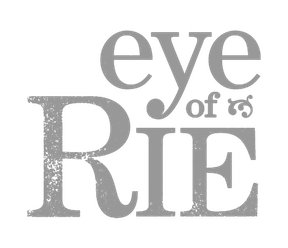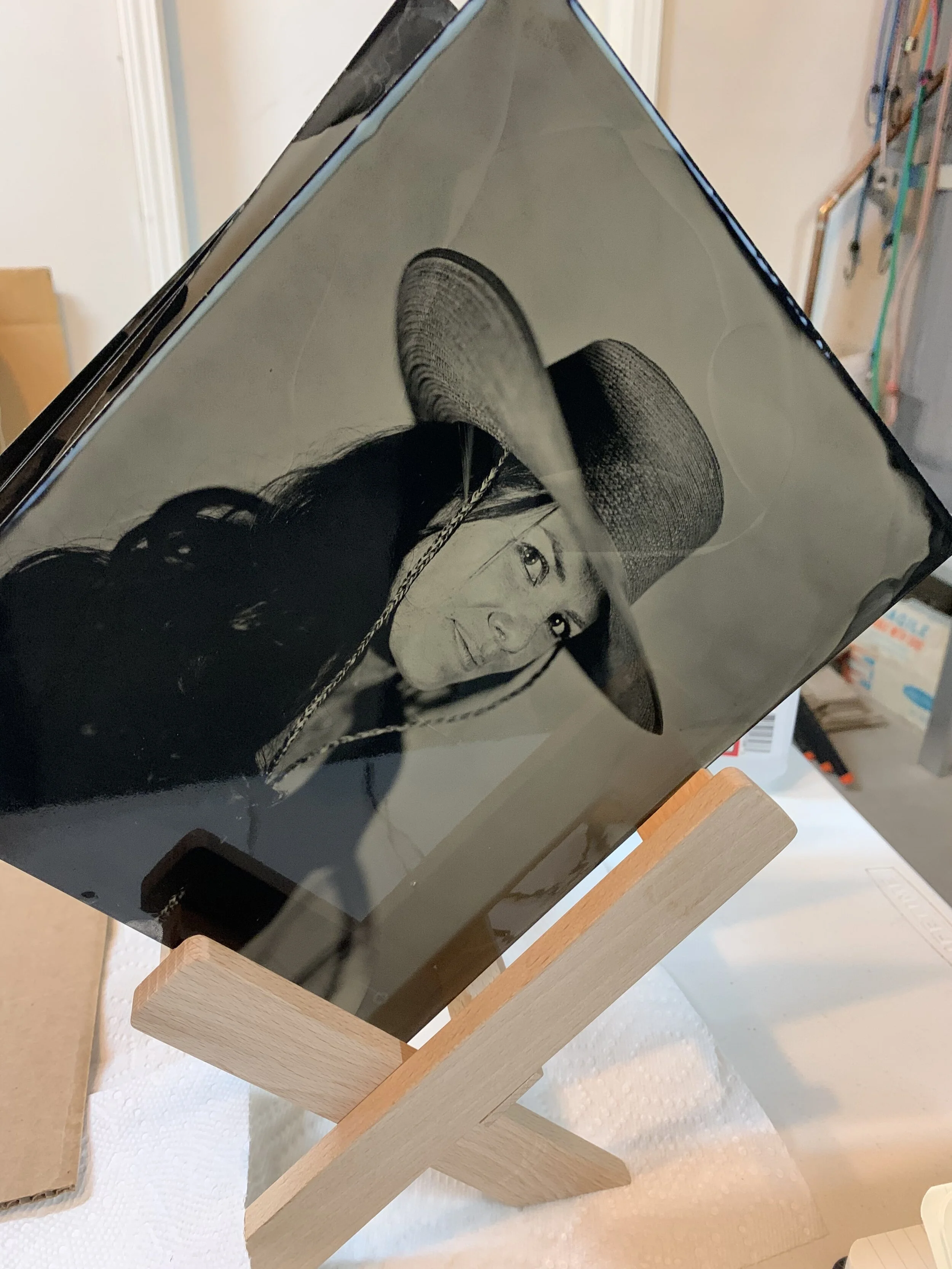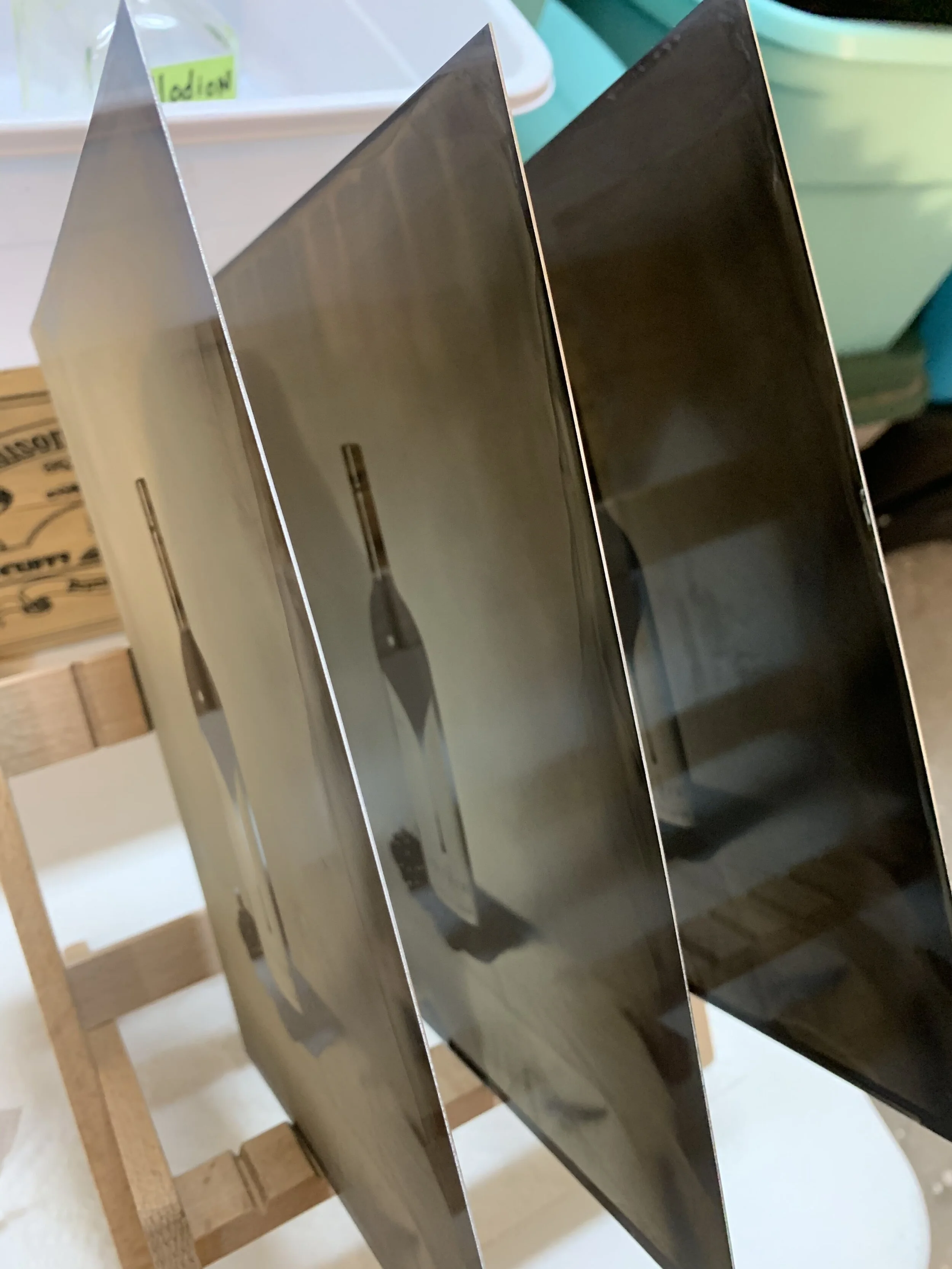“Invention is 93% perspiration, 6% electricity, 4% evaporation, and 2% butterscotch ripple.”
~Willy Wonka
Watch the process…
TINTYPES
Take home your hand crafted and archival piece of artwork made using the same technique photographers from 1850-1880 (Civil War era) used. The very same style our great-great grandparents had, and one of the earliest photographic processes, the tintype renders your very essence in a most unique way. A tintype is not a print, but a one-of-a-kind photograph created on a sheet of metal with pure silver in a chemical technique. Abraham Lincoln had his images created using this process as well!
Each tintype portrait session begins with a brief consultation. Creating a tintype portrait using this historic wet-plate collodion process means each individual plate is hand-crafted in the darkroom immediately before the photograph is taken, and developed immediately afterwards. It is during this hand-made, bespoke processes that each tintype takes on its own unique character. No two plates are alike!
Each tintype portrait session begins with a brief consultation. Creating a tintype portrait using this historic wet-plate collodion process means each individual plate is hand-crafted in the darkroom immediately before the photograph is taken, and developed immediately afterwards. It is during this hand-made, bespoke processes that each tintype takes on its own unique character. No two plates are alike!
After the plate has been exposed in the camera, and quick developing in the darkroom, the magical final phase (fixing) reveals your image. We know that tintypes can last 100’s of years and passing these down as family heirlooms are invaluable.
How long does it take? You only have to sit still for an average of 3-5 seconds (sometimes more or less, depending on the available light). You need to set aside at least 15 minutes to make one picture ( I have to prepare the plate, take the picture, develop and “fix” the plate before the chemicals dry). Another 15-20 minutes is needed to wash, dry, varnish and “set” the varnish (by heating over a flame), but I usually do that after our session and mail the finished plates to my clients.
How many people can you shoot at once? Due to the limitations and size restrictions, I can only shoot a max of 2 people for a 4x5 plate, 3 people for a 5x7 plate, and 4 people for an 8x10 plate. Since the depth of field is very shallow and small, the more difficult it is to attain a sharp focus on all subjects. If you have more people, let’s talk! I’m willing to try to extend my limits as long as you are aware of the possibilities of focus issues.
How much does it cost per session?
Traditional Tintype Studio Sessions:
A 75.00 deposit is required to hold/schedule your time slot and that amount will be applied to your final session fee.
8x10 - 195.00/ ea. (2nd plate 160.00, 3rd plate 125.00)
5x7 - 175.00/ ea. (2nd plate 140.00, 3rd plate 105.00)
4x5 - 155.00/ ea. (2nd plate 120.00, 3rd plate 85.00)
*Pets are an additional $50.00
*$25.00 per person extra for over 4 people
*$12.00 shipping if you need them sent postal.
I am now offering “Artistic Tintype Model Sessions” that are an extended 2 hour session that allows us more time to get creative! I explore more options with backdrops, lighting, posing and get more ‘out of the box’ of a traditional tintype session. This is fun if you’re looking to possibly bring some outfit changes/looks and I also have hats in the studio you can try. This session allows us to get more dramatic and bring your personality out.
8x10 - 235.00/ ea. (2nd plate 210.00, 3rd plate 185.00)
5x7 - 210.00/ ea. (2nd plate 185.00, 3rd plate 160.00)
I also offer gorgeous “Heirloom Collections” Go big or go home—but why not go big and bring home a giant heirloom tintype that screams ‘legendary’? With a massive replica and custom stands, it’s not just a portrait; it’s your family’s crown jewel!
I am also willing to do “custom packages” depending on what you desire!
What to expect… Since this process is time intensive, expect to hangout with me for at least an hour to 90 min. Feel free to ask me any questions about the process and just remember to have fun! I understand that people aren’t usually comfortable in front of a camera, but there is nothing to be afraid of and I will guide you along the way. You will get to see the process and watch as your image will appear like magic in the final stage. When we are finished, I will keep the plate with me for varnishing and I will let it cure for a few days. I will also send you a social media resolution scan of your tintype after the shoot and you will have your plate within a week or less.
How many pictures do you take? The cost is per plate and I shoot one plate at a time (generally 15-20 minutes per plate) and we can get about 3-4 plates within 60-90 minutes. Once the strobe light goes off, the image is already on the plate and there is no editing, photoshop or digital help here. Think of it as an 1800’s Polaroid!
There are marks and spots on my image. Is this normal? Yes! This is an imperfect process and there are dozens of variables within the chemistry and how everything is executed. Minor imperfections are normal with each tintype and each image is unique.
What if I’m not happy with how it turned out? Will you re-shoot? This is situational and if you don’t like your face, hair, etc., or if you are extremely particular, I can re-shoot for a $50.00 fee (per plate) to cover material costs and time. I will re-shoot at no extra cost if:
There is a chemical issue which can affect the final image or
I completely messed up! (It happens sometimes).
Do you shoot pet portraits?
It depends.
Small animals that are comfortable being picked up and photographed with their human(s) can be photographed without concern. Bigger animals must be able to hold a focused ‘sit-stay’ command for around 10-15 seconds or less.
Not all breeds photograph well - animals with dark or matte fur will often not photograph as well as lighter, shinier breeds.
Please note - I use high wattage of light to make portraits. In simple terms, it’s a really big flash. While I will try my best to get the perfect shot - with animals you often only get one shot. For best results, I recommend bringing treats, toys, and a tired-out pet!
For the comfort and well-being of our animal friends, please do not bring pets that are fearful or easily stressed.
(Pets are an additional $50.00 due to time and setup)
Do you shoot small children and babies? Children usually over the age of 5 are great candidates for a photo, but several things can happen with small children:
Babies and toddlers are easiest to photograph when held, although it is possible to photograph them by themselves.
For best results, I recommend a recently-napped and fed child, toys, treats, and perhaps a friend to assist. A tablet with cartoons can be a great trick for mesmerizing wriggly kids into holding still and looking at the camera.
Be warned - I use a big flash to make portraits. It’s perfectly safe but can be an overwhelming experience for your little one. To avoid flinching, we try not to talk about it too much before we take the picture, but it can be helpful to warn certain children first.
Can I use my image for personal use? Yes! I do give you a social media size digital file of your tintype for sharing. If you wish to order high resolution prints, I offer that as well.
Can I use my image for commercial use? With permission, yes. As with any photographer, licensing fees apply and vary depending on the use of the image. Contact me to discuss rates.
Can you make copies and/or prints from my tintype? Yes! Even though there will only ever be one original tintype, I can process your tintype and render a beautiful high resolution print for you to give to friends, family or keep for yourself! Prints up to 8x10 size are 85.00 per print.
What should I wear for my session? Feel free to wear whatever you like! Be aware that any graphics or text on your clothing will appear in reverse (mirror image). Feel free to dress up, or down. Patterns and textures always look great. Feel free to bring small props, hats, jewelry etc. Tintypes can be very high contrast - so avoid solid white or solid black. Finally, if there is more than one person in the shot, try to wear different colors, patterns and textures.. Some people like wearing vintage-looking clothing because it looks cool and authentic, while others like a more modern/traditional look. Most photos shot are usually torso length/ head-shots. If we are doing a full body shot, plan on coordinating clothing and shoe options. Just have fun!
Can I wear glasses?
It depends.
UV coating will cause the lenses to darken - sometimes this is barely noticeable, other times it will give a ‘smoked’ look to the glass. Blue-light blocker will cause the lens to black out entirely. If unsure, bring the glasses with you - or an old pair of frames without lenses!
Colors - This process is interesting when it comes to how colors translate into black and white (because it’s sensitive to UV). People are often surprised how different they look. So if you wear light blue, it will look white (darker blues are best). People with blue eyes often have very pale looking eyes. Tattoos done in blue ink, virtually disappear! If you wear red, it will look very dark, almost black. Freckles and birthmarks show up more. People who are tanned will look VERY dark.
Example of how colors change in a tintype
Makeup - AVOID: yellowish-tinted foundation or concealer, blue eye makeup, white highlighting under the eyebrows or shimmery makeup in general. Medium-darkish lipstick is recommended because lips tend to appear pale. Eyebrows sometimes look paler on blonde women (eyebrow pencil/shadow is a solution). If you use face powder to keep down shine, bring it with you to touch up beforehand.
Aren’t tintypes made on tin plates? Why do you use aluminum? Historic tintypes were actually created on iron plates and are also known as ferrotypes. Ferrotypes require that you coat the metal first with a layer of asphaltum and bake them. Some photographers working in this process make ferrotypes and that’s a personal choice. I, personally, use pre-coated aluminum for quality and consistency. They also will never rust!
Why do you bother doing all this? Why not use Photoshop? I have worked with my digital camera for many years doing different photography projects (portrait, landscape, events, advertising, etc.) and it’s quick and easy and makes sense for some kinds of commercial photography. Having said that, you can’t recreate a hand-crafted tintype on a computer. Each tintype is a unique physical object and is one-of-a-kind. They each have their own particular imperfections or tiny flaws. While you can create a similar look on Photoshop, when you go to make a print, it’s just that – an inkjet print. Even the best print simply does not have the archival quality of a varnished tintype. Even if it’s a metal print, it’s not a tintype. Plus I love the challenge of working in this process. The entire process makes me slow down and appreciate the moment of making a photograph. I connect better with the subject and it’s special for them too. What I do is rare and appreciated by people who understand the difference. Each and every plate is magical!
Do you offer tintypes for events? Depending on my schedule, I am happy to see if I can accommodate your special event needs. Doing a pop-up with tintypes is a lot to take on the road and set up, but it is a blast! Weddings, events, family reunions, parties, business meetings, etc. are a great way to make great memories that will last forever.
Tintypes will definitely entertain your guests as they watch the magic happen before their eyes. Remember, these last 100’s of years! Contact me for more information and pricing.
I’m interested in your process. Can you explain how you make a tintype in more detail?
THE PROCESS
The metal I use is aluminum trophy plate (the kind used to engrave awards and trophies). One side is pre-treated with a black coating.
I prepare the aluminum plate with the base chemical (collodion) which is poured on in liquid form. To spread it evenly over the entire plate I tilt the plate slightly while it’s horizontal to all four corners of the plate. Once covered, I pour off the excess into a bottle (to be reused). This is done quickly as the collodion immediately starts to “gel up” and will dry quickly.
I then dip the plate in a vertical tank full of silver nitrate solution. It stays in there for about 3.5 mins. The tank is enclosed in a wooden box to keep out the light because once it is coated in silver, the surface is sensitive to light. This step must be done in a darkroom or portable dark-box. I take the plate out of the silver tank and transfer the plate to the camera using a light-proof plate holder.
I focus the camera on the person I’m photographing and insert the plate holder. I then take the photograph (make the exposure). Exposures range in time depending on how fresh the collodion is, what light I am using, what the aperture the lens is and other variables.
I then transfer the plate to the darkroom or portable dark-box and develop the plate with a ferrous sulfate developer (it also contains acetic acid and grain alcohol). Then the image appears on the plate (as a negative). I wash off the developer to stop the development using distilled water. At this point I can bring the plate out of the darkroom.
I then have to “fix” the image which is the best part because it turns from a “negative” to a “positive” image. This is the magical moment!
I wash off the fixer and air-dry the plate. If I’m in a hurry I can use an oil lamp to speed up the drying process.
Once the plate is dry it must be varnished to seal it and protect it from the air. If left unvarnished, the image will eventually darken and it is subject to scratches. I pour on a gum sandarac/lavender oil varnish the same way I pour on the collodion and drain the excess. I then dry it over the oil lamp to set it. The heat gives the varnish a glossy finish. It takes 20-40 minutes average time from start to finish for one image, but depends on how many people are in the picture (if I have to pose them) and it takes longer if I’m chatting with them. :-)
NOTES:
A session includes at least one tintype for the original size booked. We will shoot several tintypes and you can choose your favorite or decide to purchase several of them! I can usually shoot around 3-4 plates within 90 minutes depending on how things are rolling along. I'm willing to re-shoot the image if there are chemical artifacts that obstruct the image or there is a chemistry issue on my part. Please keep in mind that this is a historical process with quirks and imperfections and allow some tolerance towards dust particles, soft focusing, minor flaws, fingerprints, etc. - It's what makes this method unique.
Once the session has ended, I will let you know when you can come back and pick up your plate or I can mail it to you. Time permitting, I can varnish the plate for you on the spot and you can take it home that day. Turn around time is usually less than a week for individual plates and up to 2 weeks for Heirloom Collections. I will wrap each tintype and present them in a hand made photo box when ready!
Final note: This process captures every last detail and some people find it intimidating to view themselves in this photographic format. If you are expecting an highly edited, digitally manipulated, and/or a perfect image, this type of portraiture isn't for you. My lens captures details we normally don't see which is why tintypes are referred to as honest portraits. In all the "flaws" we humans see in ourselves, I find these types of portraits to be purely striking unlike anything else. It's a truly unique form of portraiture but keep in mind that it’s not for everyone.
RESCHEDULING, REFUNDS & CANCELLATIONS:
A 75.00 deposit is due at the time of booking to hold your appointment time slot. The deposit is applied to your session cost and is refundable should you need to cancel before the 48 hour notice policy.
Due to the nature of this process, there is a lot of preparation, chemicals, and time involved. You will not be given a refund for simply not showing up for your scheduled appointment or without providing 48 hours notice. I kindly request that you give notice so that we can reschedule - no problem!
Last-minute reschedule requests that are under 48 hours are treated the same as last-minute cancellations since they result in the same loss of rebooking availability. To reschedule, you will be required to make a new deposit. Thank you!






